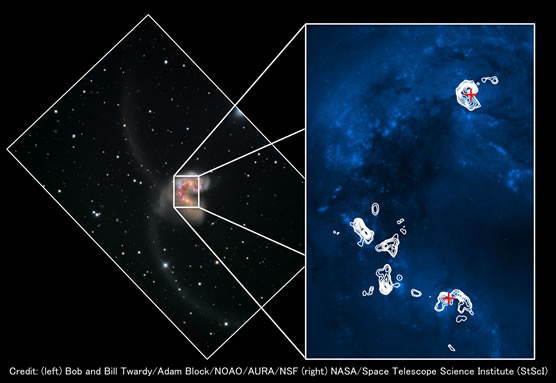
The contours on the right figure show the SMA data obtained and analyzed by the group.
Can a galaxy collision trigger massive bursts of star formation? or is it related to the growth of a super-massive black hole? In an attempt to answer these intriguing scientific questions, an international team led by researchers at the NAOJ Nobeyama and the University of Tokyo observed the nearest colliding galaxy pair from the Earth, the “Antennae galaxies”, using the Submillimeter Array (SMA) in Hawaii.
The team used the SMA to map the relatively warm and dense molecular gas cloud - the exact fuel for future star formation and black hole growth - at an angular resolution that is more than 10 times higher than previously possible. “What was only seen as a blurred picture before has now become increasingly sharp, thanks to the high resolution power offered by the SMA” says Junko Ueda who is a graduate student at the University of Tokyo and the principal investigator of the team.
The team used this new image to identify regions in the Antennae galaxies that do not show clear signs of star clusters in optical images, but have ample amounts of molecular gas clouds. These are regions that will possibly host numerous star clusters in the future, and the intense bursts of star formation could be triggered by the immense galaxy collision.
The high quality SMA image also shows new hints of gas streaming to the central region of the galaxy, which may be related to the growth of the central super massive black hole. Astronomers believe that many of the galaxies in the universe host black holes at galaxy centers.
See the website for more details:http://www.nao.ac.jp/E/release/2011/11/22/galaxy-collisions.html (SY)
